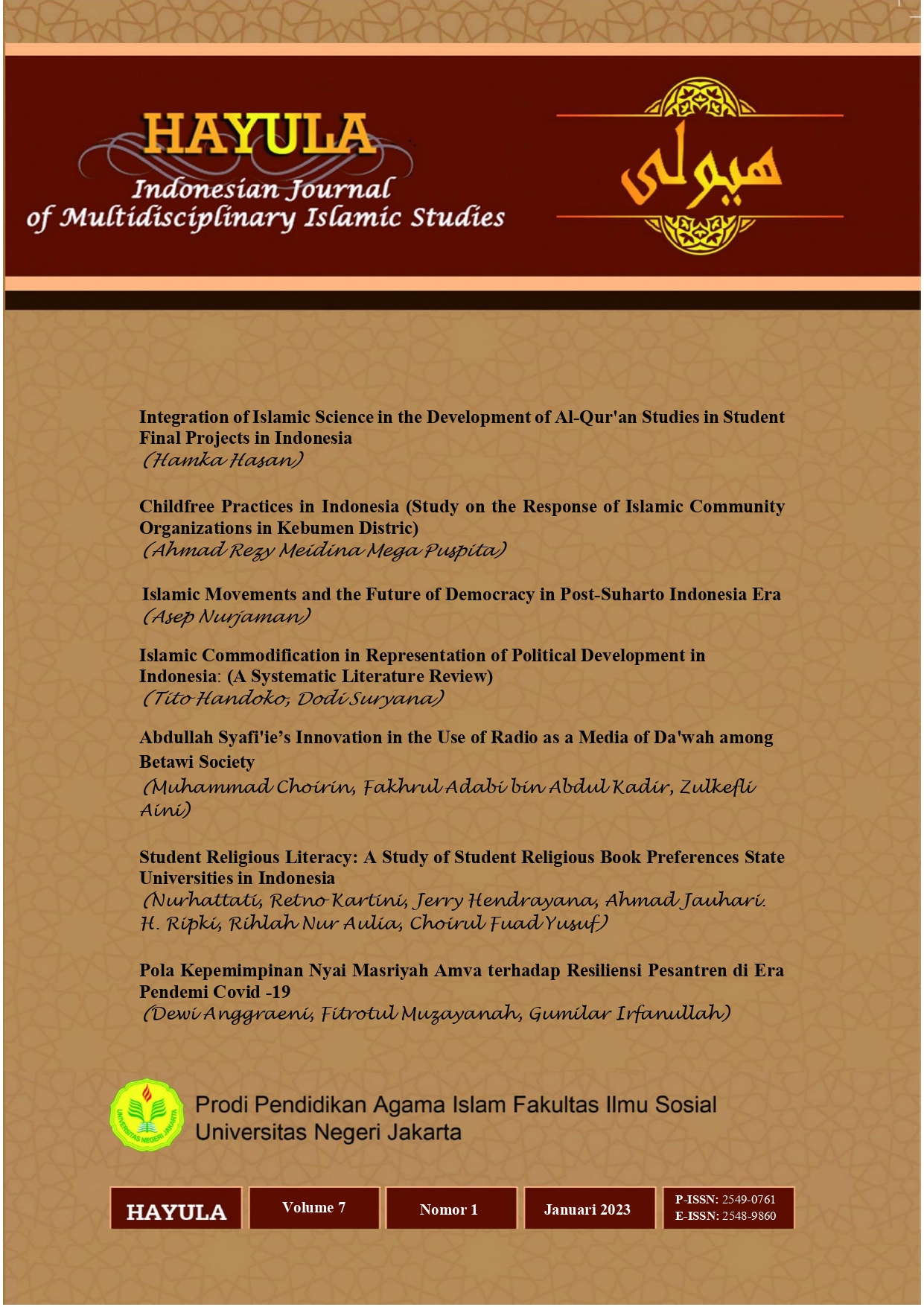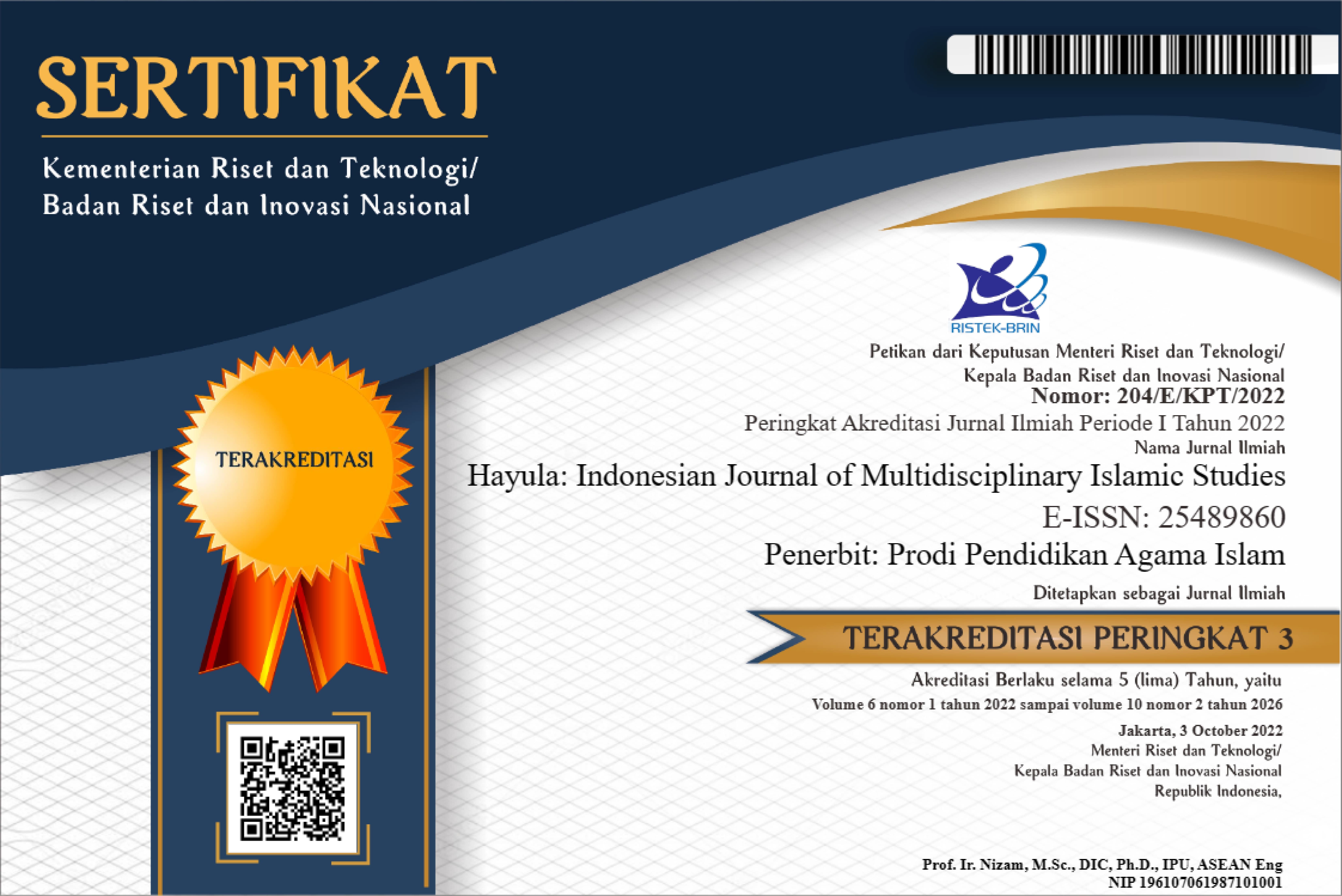Student Religious Literacy: A Study of Student Religious Book Preferences State Universities in Indonesia
DOI:
https://doi.org/10.21009/hayula.007.01.06Keywords:
Religious Literacy, Religious Book, Preferences, StudentsAbstract
This study aims to describe and analyze: (1) preference for reading religious books; (2) religious literacy, factors that influence the preference for reading religious books, and (3) formulate recommendations for the development of religious books in State Public Universities. This research used the survey method and literature review. The population is students of State Public Universities in Java, who are Muslims, including: DKI Jakarta, Banten, West Java, Central Java, Yogyakarta Special Region, and East Java. Each province has two State Public Universities, except for Banten, with a sample of 560 respondents, with a distribution of 53-60 respondents. Data collection techniques using literature review. The results of the study: First, the preference for reading religious books is at a „medium“ level, due to a number of factors including: (1) time-consuming college assignments, (2) low motivation due to perceptions of religious issues as „personal rights“, (3) an Islamic Religious Education environment that is less „motivating“, „reinforcing“, (4) the availability of religious books is not suitable for students' needs, and (5) the academic climate is less conducive which limits freedom, the breadth of reading religious books. Second, religious literacy, the micro dimension, is in a moderate position, namely the preference for reading religious books „sufficiently“has a significant effect on the development of students' abilities. Research contributions: (1) provide a factual map of preference for religious/religious books in the millennial generation at public universities in the 2018-2022 range. (2) drafting policy, providing religious books for public higher education.
References
Arumsari, N., & Rahayu, A. M. (2016). Book Review: King, Dwight Y. Half-Hearted Reform: Electoral Institutions and Struggle for Democracy in Indonesia. New York: Praeger, 2003. 256 PP. Politik Indonesia: Indonesian Political Science Review.
Baswedan, A. R. (2004a). Political Islam in Indonesia: Present and future trajectory. Asian Survey.
Baswedan, A. R. (2004b). Sirkulasi Suara dalam Pemilu 2004. Analisis CSIS, 33(2), 173–189.
Bruinessen, V. (2004). “Traditionalist” and “Islamist” Pesantren in Contemporary Indonesia. ISIM.
Buehler, M. (2009). Islam and democracy in Indonesia. Insight Turkey, 11(4), 51–63.
Christmann, K. (2012). Preventing religious radicalization and violent extremism: A systematic review of the research evidence. Youth Justice Board, 1–77.
Duile, T., & Bens, J. (2017). Indonesia and the “conflictual consensus”: a discursive perspective on Indonesian democracy. Critical Asian Studies, 49(2), 139–162.
Fionna, B. U., & Tomsa, D. (2017). Parties and Factions in Indonesia : The Effects of Historical Legacies and Institutional Engineering. ISEAS Working Paper.
Hakim, S. A. (2018). Islam and government: An analytical review on Khumayni’s Kashf al-Asrār and Wilāyat al-Fāqih. Indonesian Journal of Islam and Muslim Societies, 8(1), 147–171. ht
Hamayotsu, K. (2014). Conservative turn? Religion, state, and conflict in Indonesia. Pacific Affairs.
Hasan, N. (2020). The expansion of " salafis." In Laskar Jihad: Islam, Militancy, and the Quest for Identity in Post-New Order Indonesia. (pp. 1–33).
Hossain, A. A. (2016). Islamism, secularism and post-Islamism: the Muslim world and the case of Bangladesh. Asian Journal of Political Science, 24(2), 214–236.
Istadiyantha. (2019). Tracing the Path of Islamic Political Movements in Indonesia. Afkaruna, 15(1), 1–14.
Khamid, N. (2016). Bahaya Radikalisme terhadap NKRI. Millati: Journal of Islamic Studies and Humanities.
Kikue, H. (2011). The End of Political Islam? A Comparative Analysis of Religious Parties in the Muslim Democracy of Indonesia. Journal of Current Southeast Asian Affairs, 30(3), 133–159.
Kustana, T. (2017). Islamic terrorism in Indonesia: Addressing Government Strategies and Muslim Population. Jurnal Pertahanan, 3(2), 77.
Laisa, E. (2014). Islam dan radikalisme. Islamuna, 1(1), 1–18.
Maghfuri, A. (2019). Countering Conservative-Radical Understanding by Mainstreaming Moderat Islam and the Role of Educational Institution in Indonesia. International Journal on Islamic Educational Research (SKIJIER), 3(1), 1–14.
Menchik, J. (2019). Moderate Muslims and Democratic Breakdown in Indonesia. Asian Studies Review.
Mohajan, H. A. (2018). Qualitative Research Methodology in Social Sciences, and Related Subjects. Journal of Economic Development, Environment, and People, 7(01), 23–48.
Mujani, S., Liddle, R. W., Mujani, S., & Liddle, R. W. (2020). Public Opinion Indonesia’s Approaching Elections Politics, Islam, and Public Opinion, 15(1), 109–123.
Narulita, S., Hyangsewu, P., & Diens, A. (2022). Moderate Muslim Characters in The Quran and Its Implementation in Islamic Religious Education Learning in Public Universities. Jurnal Studi Al-Qur'an, 18(1), 75-90.
Nurjaman, A., Suprapto, B., & Masmuh, A. (2018). Nationalist Vs Islamic: The dynamic of politik aliran in post-suharto Indonesia. Pertanika Journal of Social Sciences and Humanities, 26(3), 2009–2020.
Prajuli, W. (2018). Islamic Parties, Islamic Radicals, and Democratization in Indonesia, (May).
Robison, R., & Hadiz, V. R. (2017). Indonesia: a tale of misplaced expectations. Pacific Review, 30(6), 895–909.
Satria, A., Putri, P., Sari, N., & Adriana, R. (2018). The Current State of Terrorism in Indonesia : Vulnerable Groups, Networks, and Responses, 0–18.
Shalihin, N. (2017). Understanding The Radicalism Movement In Indonesia: A Conflict Approach to the Rise of Terrorism. AJIS: Academic Journal of Islamic Studies.
Shiraishi, T. (2020). Southeast Asia Approaching Suharto’s Indonesia from 5–7.
Shupe, A. (2009). Religious Fundamentalism. The Oxford Handbook of the Sociology of Religion, 127–153.
Tajuddin, A. (2016). Development, Democracy, and Post-Islamism in Indonesia. International Journal of Social Science Studies, 4(11), 41–50.
Trihartono, A., & Patriadi, H. B. (2016). The 2014 Indonesian general election and beyond: Melting “frozen” cleavages. Asian Journal of Comparative Politics, 1(1), 25–43.
Ufen, A. (2008). From aliran parties to dealignment: political in post-Suharto Indonesia. South East Asia Research, 16(1), 5–41.
Umam, F. (2019). Ideological Involution of the Islamists. ULUL ALBAB Jurnal Studi Islam, 20(1), 25–45.
Umar, A. R. M. (2010). Melacak Akar Radikalisme Islam di Indonesia. Jurnal Ilmu Sosial Dan Ilmu Politik.
Wajdi, F., Mahfud, C., & Fauzia, I. Y. (2021, November). The Changing Trend of Islamic Pop Culture in Indonesian Reform Era. In Proceeding International Conference on Islam and Civilization (ICONIC) (Vol. 1, No. 1, pp. 165-169).
Xiao, Y., & Watson, M. (2019). Guidance on Conducting a Systematic Literature Review. Journal of Planning Education and Research, 39(1), 93–112.
Downloads
Published
How to Cite
Issue
Section
License
Authors who publish with this Journal agree to the following terms:
- Author retain copyright and grant the journal right of first publication with the work simultaneously licensed under a creative commons attribution licensethat allow others to share the work within an acknowledgement of the work’s authorship and initial publication of this journal.
- Authors are able to enter into separate, additional contractual arrangementfor the non-exclusive distribution of the journal’s published version of the work (e.g. acknowledgement of its initial publication in this journal).
- Authors are permitted and encouraged to post their work online(e.g. in institutional repositories or on their websites) prior to and during the submission process, as it can lead to productive exchanges, as well as earlier and greater citation of published works.
Users/public use of this website will be licensed to CC BY







